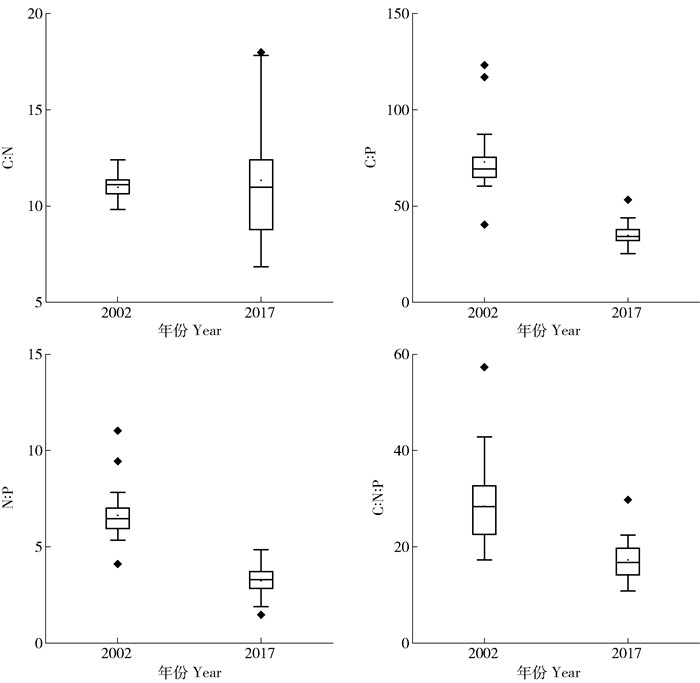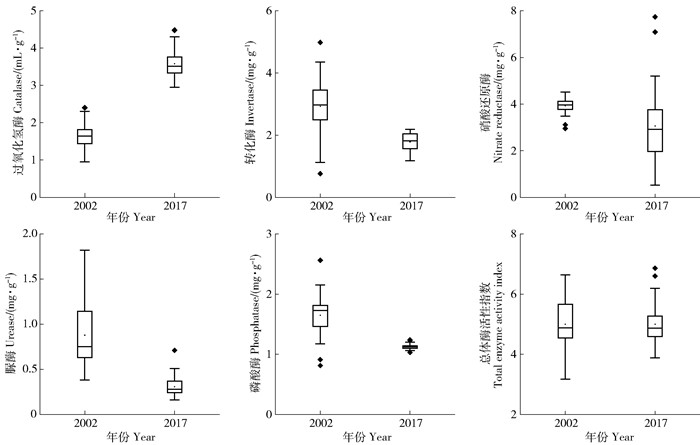-
项目名称
- 黑龙省省属高等学校基本科研业务费科研项目"复合除草剂乙·嗪·滴丁酯对农田土壤微生物多样性的影响"(2017-KYYWF-0135);哈尔滨师范大学硕士研究生创新科研项目"碳添加对盐碱草地土壤微生物数量及酶活性的影响"(HSDSSCX2018-52)
-
第一作者简介
- 郭迎岚(1993-), 女, 硕士研究生。主要研究方向:土壤生态学。E-mail:18045608945@163.com
-
通信作者简介
- 岳中辉(1971-), 女, 博士, 教授, 硕士研究生导师。主要研究方向:土壤生态学。E-mail:yuezhonghui@163.com
-
文章历史
-
收稿日期:2019-08-11
修回日期:2020-09-03
东北区黑土素来以有机质含量高、土质疏松、适宜耕作而闻名于世,是我国重要的商品粮生产基地[1]。然而,由于长期耕作和人类活动影响,已导致黑土养分流失,肥力下降,土地利用率呈逐年降低的趋势[2-3],部分耕作区表层土壤已呈酸化状态[4]。在1958—1960年第1次土壤普查时,东北黑土中的有机质质量分数还在80~120g/kg之间,部分地区质量分数高达160g/kg以上;但到1979—1985年第2次土壤普查时,黑土中有机质的质量分数已下降到60~100g/kg,因此如何有效维持黑土肥力,保障粮食产量是东北农田生产亟需解决的问题。
土壤碳(C)是构成土壤有机物质的主要元素,氮(N)和磷(P)是影响植物正常生长的重要限制元素[5],分析土壤C、N、P元素的生态化学计量特征变化不仅可以探究土壤养分的吸收策略及土壤养分循环过程中的限制因素[6],还有助于确定农田系统生态过程对全球变化的响应,利用生态化学计量特征来评估土壤肥力已越来越受到学者们的青睐[7-9];土壤酶是土壤有机物质循环过程中重要的生物催化剂[10],其活性可反映土壤生物化学反应的活跃程度及养分循环状况等[11],是评价土壤质量的潜在敏感指标和土壤肥力的重要参数之一[12]。探讨土壤生态化学计量特征及土壤酶活性的变化可以更好地了解土壤养分分配格局及循环过程。在以往黑土农田肥力的研究中,已对各种短期集约化、保护性耕作[13-14]、施肥[15-16]等耕作措施下的土壤养分及酶活性变化进行了较多研究[17-18],但对长期耕作后黑土C、N、P养分,尤其是土壤生态化学计量特征及土壤生物活性的研究则较少涉及[19];因此通过田间定位试验,在已有2002年数据的基础上,对2017年土壤C、N、P含量、生态化学计量特征及相关代谢酶活性进行研究,对比15年来土壤肥力的变化,为农田黑土的持续利用和生产力的提高提供理论依据。
1 研究区概况研究区域位于黑龙江省黑河市嫩江县,地理位置为E 124°44′~126°49′,N 48°42′~51°00′。该县土地肥沃,是农牧业生产的黄金地带,也是闻名全国的大豆和小麦生产基地及国家重点商品粮生产基地。该区气候类型为中温带半湿润大陆性季风气候,年降水量为300~770mm,年均气温为-1℃左右。
2 材料与方法 2.1 土壤样品采集与分析2017年利用GPS对2002年已获得数据的34个样地[20]进行定位后,在每个田块内随机选择15个样点,取0~20cm土层土壤,然后将田块内5个样点的土壤充分混合作为一个土壤样品,每个田块获得3个土壤样品,将样品带回实验室,去除根系后一部分自然风干过筛,用于土壤养分含量测定,另一部分装入自封袋中于4℃冰箱中保存,用于土壤酶活性的测定。
土壤有机质、全氮、全磷含量参照《土壤农化分析》测定[21]。土壤过氧化氢酶、转化酶、硝酸还原酶、脲酶、磷酸酶活性参照《土壤酶及其研究法》测定[22]。
2.2 数据处理与分析利用Excel 2017软件进行试验数据收集与整理,利用SAS 9.2软件进行试验数据的分析,最后通过Origin 9.1进行绘图。总体酶活性指数
| $ {E_{{\rm{TEI}}}} = \sum {{x_i}/\overline x } $ |
式中:xi为供试样品第i种酶活性实测值;x为同种酶活性平均值[23]。
| 表 1 土壤养分含量分级标准 Tab. 1 Ranking criteria of soil nutrient content |
由图 1可知,2017年土壤有机质和全氮含量同2002年相比显著降低(P < 0.05),降低率分别为30.00%和31.24%。其中,土壤有机质含量由原来的一、二级水平下降至以二、三级水平为主;土壤全氮含量由原来的一、二级水平下降至三级水平(表 1);2017年土壤全磷含量显著增加(P < 0.05),增加率为37.61%,由原来的四、五级水平上升至以三、四级水平为主(表 1);15年来土壤有机质、全氮和全磷的变异系数变化不大,均 < 25%。

|
图中标记代表分析时出现的异常值,下同。 Icon represents the outliers in the data analysis, the same below. 图 1 土壤碳、氮、磷含量的变化 Fig. 1 Changes of soil C, N and P content |
由图 2可知,2017年土壤C:N同2002年相比差异不显著(P>0.05),但变异系数由4.99%增加到8.48%;而2017年与比2002年相比土壤C:P、N:P和C:N:P均显著降低(P < 0.05),降低率分别为111.8%、70.2%和111.4%。

|
图 2 土壤碳、氮、磷生态化学计量特征的变化 Fig. 2 Changes of ecological stoichiometric characteristics of soil C, N, P |
由图 3可知,同2002年相比,2017年土壤过氧化氢酶活性显著增加(P < 0.05),增加率为54.02%;土壤转化酶、脲酶、磷酸酶和硝酸还原酶活性均显著降低(P < 0.05),降低率分别为66.13%、209.14%、46.14%和67.49%,土壤总体酶活性指数无显著变化(P > 0.05)。

|
图 3 土壤酶活性的变化 Fig. 3 Changes of soil enzyme activities |
由表 2可知,2002年土壤酶活性与土壤碳、氮、磷含量和土壤生态化学计量特征相关性较弱,只有土壤转化酶与土壤N:P呈显著的负相关关系(P < 0.05);但到2017年土壤过氧化氢酶与土壤C:P,转化酶与土壤有机质、全氮、全磷含量,硝酸还原酶与土壤全氮含量、N:P、C:N:P,脲酶与土壤有机质、全磷含量、C:N、N:P,磷酸酶与土壤全磷含量、N:P,总体酶活性指数与土壤全氮、全磷含量、C:N:P都显著相关(P < 0.05,P < 0.01)。
| 表 2 土壤碳、氮、磷含量和生态化学计量特征及酶活性的相关分析 Tab. 2 Correlation analysis among soil C, N, and P content, their ecological stoichiometric characteristics and soil enzyme activities |
将土壤碳、氮、磷含量、生态化学计量特征及5种土壤酶活性都作为土壤肥力指标进行主成分分析(表 3),结果表明土壤全磷含量是2002年、2017年土壤肥力指标中的主要因素;在2002年土壤C:P、N:P、C:N:P为主要肥力指标,而2017年土壤有机质、转化酶、脲酶活性为主要肥力指标。
| 表 3 土壤碳、氮、磷含量和生态化学计量特征及酶活性的主成分分析 Tab. 3 Principal component analysis of soil C, N, P content, its ecological stoichiometric characteristics soil and enzyme activities |
在黑土肥力演变的研究中,耕地土壤肥力培育是保障粮食生产和安全的基础,土壤养分、生态化学计量特征及土壤酶活性的变化则是耕地土壤肥力变化的主要驱动因素。15年来,寒地黑土土壤有机质、全氮含量均显著降低,而土壤C:N变化不显著,说明2002—2017年的15年过程中,寒地黑土微生物所利用的土壤有机质相对稳定,土壤有机质的有效性没有随年限的增加而发生改变,这与李梓瑄等[25]在1997—2012年的15年的黑土研究中发现的土壤C:N略有下降的规律不同,这是本研究发现的一个可喜现象,说明寒地黑土土壤养分代谢相对稳定,如果能够用养结合,不断培肥土壤,是可以继续维持黑土生产力的,但需要指出的是,本研究只涉及了黑土部分区域的土壤,并不能代表所有的寒地农田土壤,后续还需结合更多样品进行土壤肥力变化的研究。
笔者研究显示,15年来寒地黑土全氮含量显著降低,而土壤全磷含量显著增加,导致C:P、N:P均显著降低,且随着年限的增加降低趋势加剧,说明土壤磷素是农田养分代谢的关键限制因素,15年来长期大量磷肥的施用使得有效磷含量大幅度上升,而土壤磷素富集会导致C:P和N:P降低,最终影响土壤C、N养分的代谢过程。研究还发现,到2017年,15年来寒地黑土转化酶、脲酶、硝酸还原酶和磷酸酶活性均降低,且随土壤养分和化学计量特征的变化而变化,说明土壤酶活性与土壤养分密切相关,在土壤养分循环过程中起着重要的作用;但与上述土壤酶活性不同,2017年土壤过氧化氢酶活性显著增加,说明长期耕作使得土壤透气性逐渐加强,从而导致土壤微生物活性加强,土壤呼吸速度加快。在15年的耕作后,土壤的主要肥力因素由C:P、N:P、C:N:P转变为有机质、脲酶、转化酶(本研究各样地间pH差异不显著,在肥力因子中不考虑),说明土壤的主要肥力因素已由生态化学计量特征变为土壤养分和酶活性,这可能是由于碳、氮的不合理施用使土壤生态化学计量特征发生变化,植物对土壤碳氮磷的吸收不平衡,导致土壤养分含量分配格局发生变化,但土壤养分和生态化学计量特征的变异系数均 < 25%,说明土壤养分变化仍是以内因为主,随机因素对土壤肥力的影响较小,土壤养分平衡和生物活性仍维持在较好水平,在今后的农田生产中还应进行有机碳肥和氮肥的配合施用,同时适当减少磷肥的施用来维持土壤养分分配格局。
2002—2017年的15年过程中,土壤C、N含量降低,土壤P含量增加,导致土壤C:P、N:P、C:N:P下降,土壤酶活性也显著降低,但土壤C:N及总体酶活性指数无显著变化,土壤酶活性与土壤养分和生态化学计量特征间的相关性变强,土壤的主要肥力因素已由生态化学计量特征变为土壤养分和酶活性,说明长期耕作后,尽管土壤肥力降低,但土壤养分仍维持在较好水平。
| [1] |
刘宝元, 阎百兴, 沈波, 等. 东北黑土区农地水土流失现状与综合治理对策[J]. 中国水土保持科学, 2008, 6(1): 1. LIU Baoyuan, YAN Baixing, SHEN Bo, et al. Current status and comprehensive control strategies of soil erosion for cultivated land in the northeastern black soil area of China[J]. Science of Soil and Water Conservation, 2008, 6(1): 1. DOI:10.3969/j.issn.1672-3007.2008.01.001 |
| [2] |
韩晓增, 邹文秀. 我国东北黑土地保护与肥力提升的成效与建议[J]. 中国科学院院刊, 2018, 33(2): 206. HAN Xiaozeng, ZOU Wenxiu. Effects and suggestions of black soil protection and soil fertility increase in Northeast China[J]. Bulletin of the Chinese Academy of Sciences, 2018, 33(2): 206. |
| [3] |
GU Zhijia, XIE Yun, GAO Yuan, et al. Quantitative assessment of soil productivity and predicted impacts of water erosion in the black soil region of northeastern China[J]. Science of the Total Environment, 2018(637/638): 706. |
| [4] |
高文. 黑土地:在发展中保护, 在保护中发展[J]. 黑龙江粮食, 2015(8): 8. GAO Wen. Black land:Protection in development, development in protection[J]. Heilongjiang Grain, 2015(8): 8. DOI:10.3969/j.issn.1671-6019.2015.08.004 |
| [5] |
GUSEWELL S. N:P ratios in terrestrial plants:Variation and functional significance[J]. New Phytologist, 2004, 164(2): 243. DOI:10.1111/j.1469-8137.2004.01192.x |
| [6] |
DISE N B, MATZNER E, FORSIUS M. Evaluation of organic horizon C:N ratio as an indicator of nitrate leaching in conifer forests across Europe[J]. Environmental Pollution, 1998, 102(S1): 453. |
| [7] |
GUNDERSEN P, CALLESEN I, VRIES W. Nitrate leaching in forest ecosystems is controlled by forest floor C/N ratio[J]. Environmental Pollution, 1998, 102(S1): 403. |
| [8] |
PAZJIMENEZ M D, HORRA A M, PEUZZO L, et al. Soil quality:A new index based on microbiological and biochemical parameters[J]. Biology and Fertility of Soils, 2002, 35(4): 302. DOI:10.1007/s00374-002-0450-z |
| [9] |
曾冬萍, 蒋利玲, 曾从盛, 等. 生态化学计量学特征及其应用研究进展[J]. 生态学报, 2013, 33(18): 5484. ZENG Dongping, JIANG Liling, ZENG Congsheng, et al. Reviews on the ecological stoichiometry characteristics and its applications[J]. Acta Ecologica Sinica, 2013, 33(18): 5484. |
| [10] |
MUNGAI N W, MOTAVALLI P P, KREMER R J, et al. Spatial variation of soil enzyme activities and microbial functional diversity in temperate alley cropping systems[J]. Biology and Fertility of Soils, 2005, 42(2): 129. DOI:10.1007/s00374-005-0005-1 |
| [11] |
KRASHEVSKA V, KLARNER B, WIDYASTUTI R, et al. Impact of tropical lowland rainforest conversion into rubber and oil palm plantations on soil microbial communities[J]. Biology and Fertility of Soils, 2015, 51(6): 697. DOI:10.1007/s00374-015-1021-4 |
| [12] |
MINCHEVA T, BARNI E, VARESE G, et al. Litter quality, decomposition rates and saprotrophic mycoflora in Fallopia japonica (Houtt.) Ronse Decraene and in adjacent native grassland vegetation[J]. Acta Oecologica, 2014(54): 29. |
| [13] |
李然嫣, 陈印军. 东北典型黑土区农户耕地保护利用行为研究——基于黑龙江省绥化市农户调查的实证分析[J]. 农业技术经济, 2017(11): 80. LI Yanran, CHEN Yinjun. A study on farmers arable land conservation and utilization behavior in typical black soil area in Northeast China:An empirical analysis based on the survey of farmers in Suihua city, Heilongjiang province[J]. Agrotechnical Economics, 2017(11): 80. |
| [14] |
陈源泉, 李媛媛, 隋鹏, 等. 不同保护性耕作模式的技术特征值及其量化分析[J]. 农业工程学报, 2010, 26(12): 161. CHEN Yuanquan, LI Yuanyuan, SUI Peng, et al. Technological characteristics and quantitative analysis of different conservation tillage patterns[J]. Transactions of the CSAE, 2010, 26(12): 161. DOI:10.3969/j.issn.1002-6819.2010.12.027 |
| [15] |
程叶青. 东北地区中低产田改造的区域模式与对策措施[J]. 干旱区资源与环境, 2010, 24(11): 120. CHENF Yeqing. Regional modes and countermeasure on the improvement of medium-low productivity farmland in northeastern China[J]. Journal of Arid Land Resources and Environment, 2010, 24(11): 120. |
| [16] |
CARLSON J, SAXENA J, BASTA N, et al. Application of organic amendments to restore degraded soil:Effects on soil microbial properties[J]. Environmental Monitoring and Assessment, 2015, 187(3): 1. |
| [17] |
TIAN W, WANG L, LI Y, et al. Responses of microbial activity, abundance, and community in wheat soil after three years of heavy fertilization with manure-based compost and inorganic nitrogen[J]. Agriculture, Ecosystems and Environment:An International Journal for Scientific Research on the Relationship of Agriculture and Food Production to the Biosphere, 2015, 213(25): 219. |
| [18] |
VALBOA G, LAGOMARSIONO A, BRANDI G, et al. Long-term variations in soil organic matter under different tillage intensities[J]. Soil and Tillage Research, 2015(154): 126. |
| [19] |
TIAN S, WANG Y, NING T, et al. Effect of tillage method changes on soil organic carbon pool in farmland under long-term rotary tillage and no tillage[J]. Transactions of the CSAE, 2016, 17(32): 98. |
| [20] |
岳中辉.黑土酶活性分布特征研究[D].哈尔滨: 东北农业大学, 2006: 32. YUE Zhonghui. Studies on enzymatic distributing characteristics of black agrarian soils[D]. Harbin: Northeast Agricultural University, 2006: 32. |
| [21] |
关松荫. 土壤酶及其研究法[M]. 北京: 农业出版社, 1986: 274. GUAN Songyin. Soil enzyme and its research method[M]. Beijing: Agricultural Press, 1986: 274. |
| [22] |
鲍士旦. 土壤农化分析[M]. 第3版. 北京: 中国农业出版社, 2005: 229. BAO Shidan. Soil agrochemical analysis[M]. Edition 3. Beijing: China Agricultural Press, 2005: 229. |
| [23] |
和文祥, 谭向平, 王旭东, 等. 土壤总体酶活性指标的初步研究[J]. 土壤学报, 2010, 47(6): 1232. HE Wenxiang, TAN Xiangping, WANG Xudong, et al. Study on total enzyme activity index in soil[J]. Acta Pedologica Sinica, 2010, 47(6): 1232. |
| [24] |
全国土壤普查办公室. 中国土壤[M]. 北京: 中国农业出版社, 2002: 886. National Soil Survey Office. Chinese soil[M]. Beijing: China Agricultural Press, 2002: 886. |
| [25] |
李梓瑄, 迟凤琴, 张久明, 等. 长期定位施肥对黑土养分平衡和胡敏素分子结构动态变化的影响[J]. 光谱学与光谱分析, 2018, 38(12): 3875. LI Zixuan, CHI Fengqin, ZHANG Jiuming, et al. Effects of long-term localized fertilization on nutrient balance and dynamic change of Hu molecular structure in black soil[J]. Spectroscopy and Spectral Analysis, 2018, 38(12): 3875. |
 2021, Vol. 19
2021, Vol. 19 
